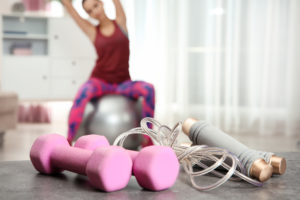
What’s a cheap piece of exercise equipment you can carry anywhere, even on vacation, and will power up your workouts? It’s a jump rope! Jumping rope offers an intense workout that can get you in shape quickly.
That’s why it’s so popular among boxers. You might not even be aware of all the benefits that jumping rope offers. Let’s look at why jumping rope belongs in your fitness routine. A word of warning: Jumping rope isn’t child’s play, although it does have an element of fun. Let’s look at some benefits of grabbing a jump rope.
Jumping Rope Is a Calorie Scorcher
How many calories you burn when you jump rope depends on how quickly you turn the rope and how high you jump, but even at a moderate pace, jumping rope burns around 300 calories in 30 minutes. That’s significant!
Of course, you can always pick up the speed to the point that you’re turning the rope two times with each jump, but that’s a more advanced move. Stick to the basics in the beginning. Start with basic rope jumping at a moderate pace at first. Do this by jumping once each time you turn the rope.
It’s a Good “Filler” between Strength-Training Moves
When you’re short on time, you can use a jump as part of a circuit workout that includes strength training. After warming up, do a strength training movement, like push-ups. Then, do 30 seconds of jump rope to boost your heart rate.
Then, proceed to the next strength move followed by 30 seconds of rope jumping. Keep alternating back and forth. With a workout this intense, you only need 20 minutes to get fitness benefits.
Jumping Rope Improves Aerobic Capacity
Aerobic capacity refers to aerobic fitness and the ability to sustain exercise at a sub-maximal level. To improve your aerobic capacity and boost your cardiovascular fitness, jump at an intensity equal to 50 percent to 80 percent of your maximum heart rate.
Use an online calculator to determine your own maximum heart rate based on age. You can check your heart rate by checking your pulse for 10 seconds and multiplying by 10. Gradually increase the intensity over time as you get better conditioned.
It Supports Bone Health
Since jumping rope is a high-impact exercise, doing it regularly stimulates bone tissue. In response, bone precursor cells called osteoblasts lay down new bone tissue. That’s beneficial for bone health.
Women, in particular, have to worry about bone loss as they age. Osteoporosis is one of the most common health problems in women over the age of 60. In fact, a study published in the journal Bone found that guys who jumped several times per week developed an increase in bone density.
Jumping Rope Develops Coordination and Agility
Jumping rope is an excellent way to improve hand, arm, and eye coordination. That’s why so many couches have athletes grab a jump rope and go to work! When you twirl a rope over your head and jump, your brain and nervous system are forced to learn new movement patterns.
Jumping over the rope will become easier with time. The coordination and agility you gain from jumping rope can help if you play sports too. Jumping rope can also boost your running speed.
Jump Rope Can Be a Warm-Up Move Too
Never start a workout with cold muscles. Lightly jumping rope for five minutes is a good way to warm up your entire body before your official workout. Be sure to keep the intensity low if you’re warming up. The idea is to warm up all the muscles you’ll be working in a manner that doesn’t create too much fatigue. No point in getting winded before you begin your workout!
How to Get Started
First, you’ll need a jump rope. You can buy weighted jump ropes, but there’s no need for that in the beginning. Choose one that’s appropriate for your height. The best way to determine this is to:
Hold the two handles of a jump rope while standing in the middle.
Pull the handles up on each side until there’s no slack.
The top of the handles should come rise to just under the top of the armpits.
Always wear a sturdy pair of athletic shoes, one that offers good ankle and arch support and has enough cushioning on the mid-sole. Fitness experts often recommend cross-trainers as they tend to offer good foot and ankle support. Choosing the right shoe will lower your risk of injury and reduce repetitive trauma on the joints in your feet and knees.
Remember, jumping rope is a high-impact exercise. Once you’re into it, it may bring back happy memories from childhood! No need to overdo it in the beginning. Stick to 5 or 10 minutes and gradually increase the time. You’ll be able to jump rope longer as your endurance increases. Don’t forget to do a cool-down afterward and stretch your quads, hamstrings, and calves.
Keep at It!
Now that you’ve gotten the hang of it, keep going! Since jumping rope is an intense exercise, don’t do it every day. Your body needs a break after high-impact exercise. Instead, jump rope 1 or 2 times per week as a substitute for some other aerobic activity. Give yourself a day or two of rest between jump roping sessions. Also, if you have joint problems, talk to your physician before making rope jumping part of your training.
Now, you know how to get in shape, lose weight, improve your stamina and aerobic capacity, and boost your coordination, all while reliving your childhood! Jumping rope adds an element of fun to exercise. Enjoy!
References:
Bone. 2015 Oct; 79: 203-212.
University of Notre Dame Performance. “Self-limiting Exercise: Jumping Rope”
